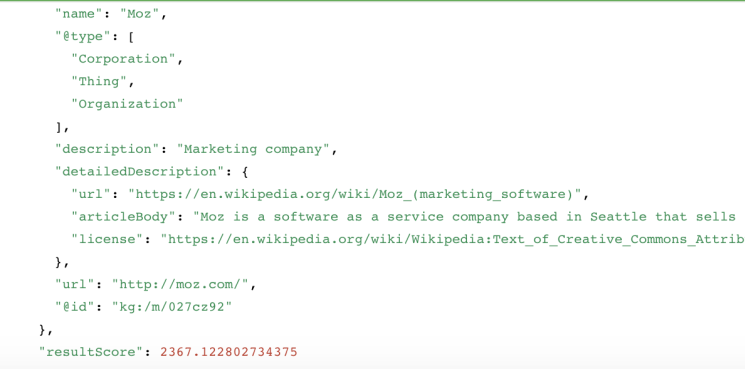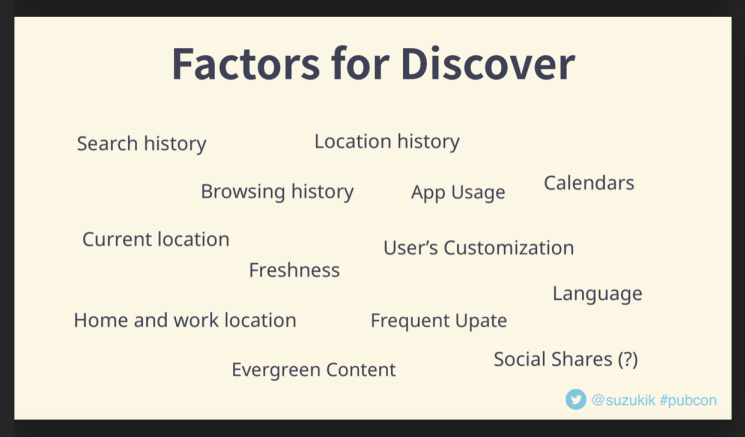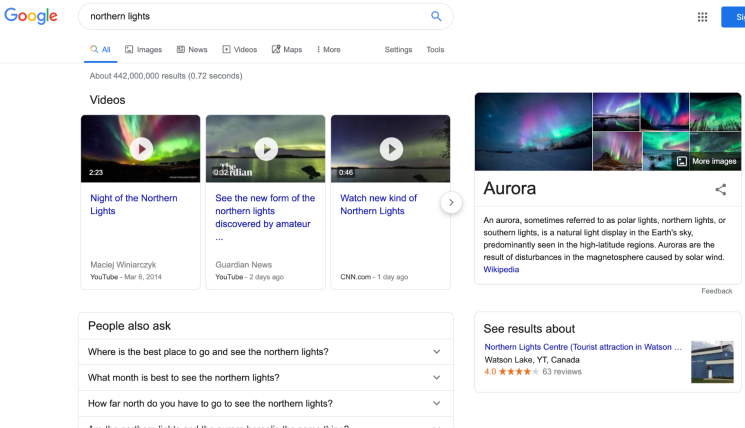Please note this article was originally posted to Moz blog. I’m posting an extended version here for my readers.
It is without a doubt that as SEOs, it is our job to keep one eye on the future to see what Google is planning, testing, and looking to drop on our doorsteps.
Over the past 12 months, we have seen a great number of changes in Google Search; each of which has impacted how we plan, implement and report on our campaigns.
Sugan
In this article, I will be taking a look at what is in store for us in 2020 and how this will change the way we formulate and implement strategies throughout the next 12 months and beyond.
Artificial intelligence will continue to evolve
Over the past half-decade, artificial intelligence has become a pioneering force in the evolution of SEO.
In 2015, for example, we were introduced to RankBrain, the machine-based search algorithm that helps Google push more relevant results to users.
Although RankBrain is coming up to its fifth birthday in just under 12 months, we are only now catching the early glimpses of how artificial intelligence will dominate SEO in the coming years.
The most recent step in this progression of artificial learning is, of course, the introduction of Bidirectional Transformers for Language Understanding (BERT), which was announced by Google at the end of October.
For those who missed it, BERT is Google’s neural network-based technique for natural language processing, and it’s a big deal, as it deals with the very fundamentals of how people search.
Google itself said that the algorithm represents, “the biggest leap forward in the past five years, and one of the biggest leaps forward in the history of Search.”
Affecting one in ten searches, BERT gives Google a better understanding of how language is used and helps it comprehend the context of individual words within searches.
The important thing to know about BERT (and also RankBrain), is the fact that you cannot optimize for it as confirmed by Danny Sullivan.
But what does this mean for SEOs?
BERT is just one signal of how Google understands language, but it is one of the most important in the search engine’s arsenal.
This means that now more than ever, webmasters and SEOs alike must focus their efforts on creating the most useful, natural, and highest quality content.
Quite simply, as Danny Sullivan says, “write content for users.”
It’s also worth understanding how BERT understands questions, and you can find out more about this subject in this Moz article by Britney Muller.
Voice Search is here to stay
In the dying days of 2019, it is hard to imagine that when Voice Search was released in 2012, many assumed it would be just another project consigned to the ever-growing Google graveyard.
Today, however, we know so much more about the technology, how it has slowly leaked into our lives, and thanks to schema.org, where it is likely to go in the future. The adoption rate is relatively slower than predicted and it’s a long way from being a primary driver. However, we must not completely ignore the Voice search.
Nearly every month a new form of markup is released, with one of the latest developments being markup for movies. Although this might seem insignificant, the mere fact that we are now seeing markup for films shows just how granular and far-reaching structured data has come.
With smart speakers now numbering 120 million in the US alone, webmasters should now be taking the time out to investigate where schema can be placed on their website so that they can take advantage of the 35.6 million voice search demands taking place every month.
What’s more, website markup has a monumental influence on featured snippets, which can be highly lucrative for any website.
Take a look at this MozTeam guide for more information on how voice search influences featured snippets.
If you’re in the US, it’s also worth noting that Speakable (BETA) is used by Google’s Assistant to answer people’s questions about specific topics. The assistant can return up to three relevant articles and provides audio playback using text-to-speech markup.
Implementing such markup can be highly lucrative for news sites, as when the assistant provides an answer, it also attributes the source and sends the full article URL to the user’s mobile device
If you’re a news site that publishes in English but doesn’t yet have Speakable markup implemented, you can read up on both the technical considerations and content requirements necessary for eligibility.
You should also consider Google actions. According to Wiki, Actions on Google is a development platform for the Google Assistant. It allows the third-party development of “actions”—applets for the Google Assistant that provide extended functionality. Actions can be used to get things done by integrating your content and services with the Google Assistant.

You can build (Dialogflow) and deploy actions and get your apps used by Google assistant. You can have users search for your specific app by name and engage with it or have users ask for something your action provides and get Google assistant to recommend your app for that information. It’s the most beautiful thing about Google actions.
Here is a fantastic article by Andrea Vopini about how to optimize your content using Google assistant.
Google is heavily invested in using entities
Entities aren’t something that you see SEOs speaking about every day, but they are something that Google is putting a lot of resources into.
Put simply, Google itself states that entities are: “A thing or concept that is singular, unique, well-defined and distinguishable.”
And entities don’t have to be something physical, as an example can be something as vague as an idea, or a color. As long as it is either, singular, unique, distinguishable, or well-defined, it is an entity.

As you can see Moz shows up in the Knowledge graph because the company is an entity. If you search Google Knowledge graph API for the company name you can see how Google understands them.

As you can see when I search for ‘Moz’ the API output shows Google is pulling information from Wikipedia. Lately, Google is pulling information from a variety of other sources as well including home page and 3rd party sites.
If you’re serious about Brand SERPs then you should Follow Jason barnard.
Here is how my entity results used to show up (Update: I lost my entity as of May 2020 due to some mistakes from my end. I will talk about this is in a separate article )


But what does this mean for SEOs?
In 2015 Google submitted a patent named “Ranking Search Results Based On Entity Metrics”, which is where the above entity description is sourced from.
Although few patents are worth getting excited about, this is one that has caused a stir in the technical SEO scene.
This is because it takes machine-learning to an entirely new level, allowing Google to accurately calculate the probability of user intent, and giving it an understanding of both their language or tone.
What’s more, entities place a reduced reliance on links as a ranking factor, which, depending on what your SEO strategy is, could result in the need for big campaign changes.
The most important aspect you will need to consider is how Google understands the entities on your website.
If your site sells shoes, for example, you need to think about how many different kinds of types, colors, sizes, brands, and concepts there are around something as simple as shoes.
Each shoe will represent a different entity, which means you must consider how to frame each product so that it meets the expectations of users, as well as the learning capabilities of Google — which is where we meet markup once again.
If you want to learn how to optimize for entities I recommend you check out WordLift and the WordLift blog has a lot of articles around this topic.
Of course, sites themselves can become entities, which can provide huge rewards, as they will appear in the Knowledge Panel, which I will discuss next.
The knowledge graph will be important for personalities and brands
Although Google’s Knowledge Graph was launched way back in 2012, its expansion across the years means that it is still a core part of the search matrix and one that will reach far into the next decade.
Closely tied with featured snippets and rich results, earlier in the last year, Google began allowing entities to claim their own Knowledge Graph panel, allowing them to edit and control the information presented to users in search results.

You can claim your business’ Knowledge Panel in a few easy steps:
- Ensure that your website is verified with Search Console.
- Update your panel by suggesting a change to Google.
You can make specific requests, such as changing the featured image, panel title, and social profiles provided within the panel.
The benefits of claiming your Knowledge Graph panel are numerous and Google said: “Put your best face forward. Make sure your audience sees the most accurate, authoritative, and engaging information about you. You can suggest changes to info that shows up on Search, including images, stats, or other facts.”

What’s more, users gain quick access to your site, which thanks to the Knowledge Graph, displays trust and authority signals.
Moving forward, Knowledge Graph panels will provide brands and personalities with the ability to control what objective information is shown to users. Despite this, however, there are still many high street brands that are yet to claim their own panels.
Another recent update Google made to Knowledge panels is the introduction of Google cameos. Once you become an entity and become eligible to obtain personal knowledge you will be invited to Cameos. Using the app you will be able to answer Q&As to your fans/users and these short videos will be directly displayed in the SERPs.

Here is how my good friend Saijo George is appearing in the knowledge graph along with the cameo Q&A videos.
But what does this mean for SEOs?
As you can see from the above examples, Having a Knowledge graph (Business or personal) can be helpful to add trust and authenticity to your business or personal brand. Also, get additional visibility. So, how can one go about getting a knowledge graph?
The short answer is: it’s hard. It takes a lot of time and work to get there if you’re not a recognized/famous person/brand. Obviously having a Wikipedia page is the easiest way to get a Knowledge graph but I don’t recommend you go and create a page cause it will be promptly deleted. My advice would go about building brand mentions and authorships around your name gradually. Having a wikidata page can be helpful but it’s not guaranteed. The idea is to get Google to recognize you as a notable person/brand.
Jason Barnard wrote this excellent article and did this presentation which shows how to optimize for the Knowledge graph in more detail.
You can use Carl Hendy’s Knowledge graph search tool to search for entities.

Jason’s brand SERP tracking tools allows you to track your brand/name strength in Google SERPs.
Here is an example of the Kalicube pro tool interface tracking my name’s visibility.

Query-less proactive predictive search is getting better
In June 2017 Google Discover was released, prompting a new kind of search altogether — one that is query-less. In fact, Discover is an AI-driven content recommendation tool and claims 80 million active users.
Using the aforementioned Knowledge Graph, Google added an extra layer, which it calls the Topic Layer, and is engineered to understand how a user’s interest develops over time (this article by The University of Maryland offers an in-depth explanation of topic layers and models).
By understanding the many topics that a user is interested in, Discover identifies the most accurate content to deliver from an array of websites.

How Google proactively predicts and shows personalized content feed.
To appear in Discover, Google states that pages appear, “if they are indexed by Google and meet Google News content policies. No special tags or structured data are required.”
As ever, ensure that you create high-quality content that is unique and creates a great experience for users. If your site tends to create clickbait articles, the chances of them appearing in Discover are low.
Having your articles show up in the discover feed might be an additional way to drive organic traffic to your site because it doesn’t rely on a user doing a Google search instead of proactively shown something that interests them.
But what does this mean for SEOs?
Google states that it ranks content based on an algorithm that inspects the quality of content alongside the interests of the user and the topic of the page in question. The exact formula is unknown however based on several studies and experiments we can get a pretty good idea.

The above screenshot is from a presentation by Kenichi Suzuki which highlights some of the factors.
I spoke to JR Oakes from Locomotive, who has done several experiments with Discover. When I asked him about the potential ranking factors based on his tests, He responded by saying;
“So regardless of medium, if you have a history of search interest in a topic, in this case “search engine optimization”, and several hundred people, Now have the same interest, visit a new piece of content, it is likely to be shown for you.”
The search engine states that there are two ways to boost the performance of your content within Discover:
1. Post interesting content 2. Use high-quality images.
According to Google: “Publishers experience a 5% increase in clickthrough rate, a 3% increase in time spent on their pages, and a 3% increase in user satisfaction when Discover cards feature large images instead of thumbnail images.”
Other tips would be to arrange your content semantically so that Google finds it easier to understand your work and ensure that your website is technically proficient.
Another interesting thing I found recently is that every time you search for something on Google, they tend to show a “Follow” button next to entities. If you click follow I believe you’ve shown frequent updates around that entity. So it goes back to entities and the importance of entity optimization.

You can also provide feedback on individual articles and It’s clear Google is using this signal to further refine the type of content to show it to particular users.

Here is another example when I searched for star wars trailer once on Youtube Google discover feed later showed me the nearest cinema where I can watch the movie, cast information, and movie reviews. Now think about that for a second. This is where the search is going!

Like any form of Search, you can track and utilize Google Search Console to see how well your articles are performing in Discover.
You can find Discover stats under the performance.


Google discover analytics data is fairly new limited. Google doesn’t provide a native way to segment this traffic inside Google Analytics. If you want to track user behavior data you can use the following technique to track it inside Google Analytics.
If you want more reading, here is a great article by Aymen Loukil on how to optimize for Google discover.
We are yet to see the biggest changes in Visual Image Search
In January 2019, John Mueller, while speaking at a Webmaster Meetup in New York, stated that in the coming year, there were to be major changes in Image Search.
Rather than merely viewing images, Mueller said that very soon, people will use Image Search to “accomplish goals”, purchase products, and learning new information.
Google has always stated that images should be properly optimized and marked, and if you’ve not started to add such data or information to your images, now is definitely the time to start.
It could be argued that the biggest change to Image Search happened in September 2018, however, when Google Lens rolled out to Image Search.
Not only did featured videos begin appearing in Image Search, but AMP stories were also released, and new ranking algorithms and tags were also rolled out.
And in the past six months alone we have seen Google introduce small changes such as removing the “view image” function from Image Search, and colossal ones, such as totally revamping Image search for Desktop.
Furthermore, people don’t even have to search within Image Search to see images anymore, as it is quite common for the results to present a universal search result, which encompasses images, videos, maps, news and shopping listings. The opportunity to appear in a universal (or blended) result is just another reason why properly tagged and marked images are so important.
Google has added visual image search attributes to search results. The interesting thing is that it’s now available for image carousels inside the main search results.

But what does this mean for SEOs?
With so much to play with, webmasters and SEOs (especially those in e-commerce), should consider how they can utilize and take advantage of such changes, which could prove potentially very lucrative for the right sites — especially when you consider that 35% of Google product searches return transactions in as little as five days. I have written an article about visual search here. You can also check this advance article by the brilliant Gianluca here.
E-A-T doesn’t apply to every site — but it still matters
E-A-T is something that every SEO should know back to front by the end of 2019, but there are still a few factors that are worth remembering, such as:
- E-A-T isn’t a ranking factor.
- E-A-T is critical for YMYL topics and pages.
Although these two statements might seem contradictory, it makes more sense when you consider what Google defines as Your Money or Your Life.
According to Google’s Rater Guidelines, this is a page or topic that, “could potentially impact a person’s future happiness, health, financial stability, or safety.”
This means, therefore, if your page has information that could potentially change a person’s life, it is a YMYL page and offering expertise, authority, and trustworthiness (E-A-T) is important.
If your site is merely your personal collection of cat pictures, then showcasing authority or expertise is less critical.
The issue, however, is that the majority of websites, and certainly the ones invested in SEO, are generally going to have YMYL pages or topics.
Over the past few years, Google has taken big steps to ensure that only the highest quality and most trusted content is being shown to users.
Whether through the rise in fake news, the spread of misinformation in health industries or because of government scrutiny, the search engine is taking big steps to ensure that low-quality or questionable content is weeded out from the results.
But what does this mean for SEOs?
As you might already know, you can’t optimize for E-A-T, as it isn’t an algorithm, but you can take important steps to ensure that your site sends the right kind of quality signals to Google.
This Moz article by Ian Booth and the guide by Lily Ray offers a great illustration of how to do that.
Topics and semantics over keywords
You may have noticed a theme throughout this article, which is that Google is putting less priority on both links and keywords, which is where topic modeling and semantics come into the fore.
Google has become very clever at being able to understand what a user is searching for based on just a few basic words.
This is thanks, in part, to topic modeling, as Google itself admitted in September 2018 when it introduced its “topic layer”. Indeed, this algorithm has a deep understanding of semantics and quite simply yearns to provide users with deep troves of information. But what does this mean for SEOs?
This means that it has never been more important to create high-quality, in-depth, and meaningful content for users — but you also need to think about information structure.
For example, if your site sells running trainers, you could create long-form educational pieces about how to choose trainers depending on specific running environments, different kinds of athletic diets for runners, or tech accessory reviews. These could be clustered into:
- Food & Fitness
- Trainer Hub
- Fitness Tech
By clustering your topics into compartments through your website architecture, both users and crawlers can easily navigate and understand the content provided.
Studies have also shown that Google’s crawlers prefer pages with semantic groupings and sites that are designed around topic modeling. This 2018 presentation by Dawn Anderson gives a brilliant insight into this.
How can you find and optimize for topics?You can use a dedicated tool like MarketMuse or SEOMonitor to do topic analysis.

If you want to know more about topic modeling and semantic connectivity, check out this Whiteboard Friday article
Search results pages (SERPS) will continue to evolve
Over the past few years (and much more so in the last 12 months alone), we’ve seen the search results evolve and transform like never before.
In fact, they have changed so much, that essentially being placed first on the organic search results, in some cases, is not the most lucrative position.
And this is something that would have been unthinkable just a few short years ago (check out this Moz article from 2018 that works to quell the panic from zero position SERPs).
With the introduction of Voice Search, rich results, rich snippets, knowledge graph panels, Google My Business (for local companies), updated Image Search results, SEOs now need to consider a whole new range of technical marketing strategies to appear in a multitude of organic search results.
Where Google is to take the SERPs in the next 12 months is hard to say, but it is without a doubt that the strategies that we use today will likely be outdated for the search environment in as little as six months’ time.
Google decided to remove the favicons from the SERPs after a backlash recently.

Favicons no longer show up in the search results.
But what does this mean for SEOs?
Ensure that you strategies are flexible and constantly prepare for changes in both your business sector (if you do not work within SEO) and the constantly evolving search environment.
Pay attention to the seasonality of searches and use tools such as Google Trends to cover any out of season deficit that you could encounter.
You can use tools like Moz Keyword Explorer to help plan ahead to create campaigns and strategies to provide useful traffic and lucrative conversions.
Consider search intent and the type of SERP results showing up for a given query. For example Google might decide to show more videos for a query over images and it makes sense to produce videos and optimize for the query for a maximum probability of ranking for that query.
A good practice would be to look at the SERPs for your query. See what Google is showing and use it as a way to determine the content type you produce.

In this search for “northern lights” you can see how Google is showing different kinds of results including video carousels, Knowledge graphs, People also ask, Images.
Conclusion
As ever, SEOs need to be moving away from the ideology that links and traditional search results are the priorities of an organic campaign.
Although both still carry weight, without investment in technical strategy or willingness to learn about entities or semantic connectivity, no SEO campaign can reach its full potential.
The world of SEO in 2020 is one that is bright and exciting, but one that will require the most investment and intelligent strategy than any other year so far.
Let’s talk & work together
Whether through my agency or as an independent consultant, I am here to help your business or project succeed.
Related articles
Stay updated!
Subscribe to get latest news, insights, technology, and updates.
" " indicates required fields





